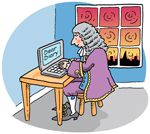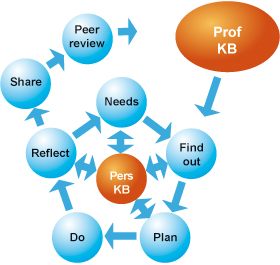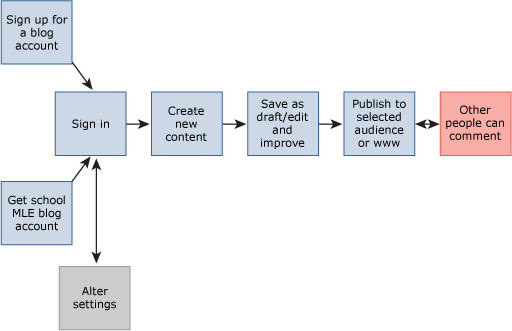Use 'Print preview' to check the number of pages and printer settings.
Print functionality varies between browsers.
Printable page generated Thursday, 25 April 2024, 10:25 AM
V02s: Blogs: skills for subject specialists
Course information

You will need access to:
- a computer with a web browser
- a class/group of students – groups could be within classes, whole classes, or groups across classes (e.g. clubs) and schools (e.g. clusters of schools or in collaborative projects).
Duration of the course: 20 hours over eight weeks
- Online total: 12 hours
- Offline total: 8 hours
- face-to-face: none
- workplace: 8 hours (setting up and using blogs with learners, making and recording observations about their use)
Learning outcomes
Professional and reflective practitioner skills
At the completion of this course, you should be able to:
- identify opportunities for the effective use of blog supported learning activities linked to your curriculum plans
- reflect on, and discuss, the impact of the use of a blog on learning.
Practical skills
At the completion of this course, you should be able to:
- set up a blog including options for comments and syndicating feeds
- publish a blog entry and comment on other blogs
- incorporate text and other media on a blog page
- manage users (authors, reviewers etc) of a blog.
Knowledge and understanding
At the completion of this course, you should be able to demonstrate an understanding of:
- the issues involved in selecting the appropriate blog tool for your context and intended learning purpose
- key copyright and e-safety issues when creating and sharing content on a blog.
Cognitive skills
At the completion of this course, you should be able to:
- critically review the use of blogs in educational contexts and share these reviews with others
- discuss different ways in which blogs might be used in learning contexts in schools.
Course schedule
| Week | Course Activities | Type | Approx time needed |
| 1 | Activity 1 Getting to know others on the course | Online | 45 minutes |
| Activity 2 What are blogs and why use them? | Online | 45 minutes | |
| Activity 3 Blogs and e-safety | Online | 45 minutes | |
| Activity 4 Caring about copyright | Online | 45 minutes | |
| 1-2 | Activity 5 Online field trip | Online | 2 hours |
| Activity 6 Using other Web 2.0 technologies with blogs | Online | 30 minutes | |
| 2-3 | Activity 7 Finding relevant examples | Online | 1 hour |
| Activity 8 How might you use blogs? | Online/workplace | 2 hours | |
| Activity 9 Selecting a blog tool | Online | 1 hour | |
| 4-7 | Activity 10 Setting up your classroom blog | Workplace | 1 hour |
| Activity 11 Using the blog with your students | Workplace | 5 hours | |
| 8 | Activity 12 Reflecting and reporting back | Online/workplace | 2 hours |
| Activity 13 TDA Professional Standards | Online | 30 minutes | |
| Activity 14 Extracting our shared learning | Online | 1 hour | |
| Activity 15 Course evaluation and certification | Online | 1 hour | |
| Total | 20 hours |
Introduction

The course takes a reflective practice model to look at how blogs allow for individual and shared reflection online. You will be introduced to some theory and practice of how blogs are used in schools, plan for their use in your school and reflect and discuss their use in learning and teaching
The course begins by looking at existing blogs with an emphasis on those used in educational contexts.
You will discuss the issues raised by the use of blogs in terms of e-safety and learning and teaching.
The course will provide guidance on creating and using blogs and you will set up your own and trial it with some students, either using a blog on your school’s learning platform or, if this is not available, on one of the free online blog services.
Throughout the course, and especially after you have used your blog with pupils, you will share experiences with other participants.
The reflective cycle
Vital courses are based on a cycle of professional reflective practice as shown in the diagram below.

This cycle draws on, and develops, personal and professional knowledge bases. The latter may be seen in the literature, resources, policies and other materials that are used to inform practice.
Throughout the course small icons will indicate the stage of the cycle being addressed.
NB Prof/Pers KB = Professional/Personal knowledge base
Introducing ourselves through a blog
In this part of the course we will introduce ourselves and find out about blogs by using the course blog. We will clarify our understanding of what a blog is and why you might use a blog in teaching and learning. Now let's find out who else is on the course.
Activity 1 Getting to know others on the course
![]() The objectives of this course activity are to:
The objectives of this course activity are to:
- get to know the other participants on this course
- begin to clarify your ideas about blogs, through using one.
1.1 Go to the course blog and introduce yourself, telling the other course members what you hope to get out of the course.
1.2 Go to the course blog and read what others have posted. Use the 'comment' option to respond to others that are already there.
Introducing blogs

Most people have heard of blogs and many will have read them, although not always realising that is what they are doing. The term 'blog' is shortened from the term 'weblog' and can be thought of as a website with a set of tools that make to easy to publish. They are called ‘logs’ because the posts are organised chronologically like a diary.
Often, blogs are maintained by an individual person who posts a message, maybe with images etc, online. Others can comment on these posts as you did in the previous activity. Alternatively, multiple users can publish content in shared blogs or a collection of individual blogs can be 'pulled together' (aggregated) to make it easier to manage group communications.
Don't worry if this sounds a bit complicated, as you progress through the course and see the different types of blogs and you will get to understand how the world of blogging works.
Activity 2 What are blogs and why use them?
![]() The objectives of this course activity are to:
The objectives of this course activity are to:
- develop your understanding of what a blog is
- develop a rationale for including blogs in your teaching.
Watch this video (3 minutes) from Commoncraft for a brief introduction to blogs.
If the video does not appear then there may be firewall/filtering issues. The video is less than five minutes long and you are advised to watch it on a machine that is not filtered if possible, or read the alternative description linked below.
For an alternative description of a blog please see this Becta (2010a) resource.
Now read Stephen Downes’ blog post, Blogs in Education. He provides a useful introduction to blogs and the benefits of using them in education.
Go to the course forum and share your initial thoughts and experiences of using blogs. Can you see any opportunities or benefits of using blogs within your teaching?
Discussion
Want to find out more? (optional activity)
Anne Davis provides a useful rationale behind using blogs in education. This blog post has received over 140 comments from educators around the world!
E-safety when using blogs

E-safety is a topic of common concern with children using the internet. In this part of the course you will think about how a blog can be used safely and ethically. You will identify e-safety issues related to the use of blogs in schools and share your thoughts with others. You will have an opportunity to reflect on the responsibilities of authors and how to ethically use content developed by others.
Activity 3 Blogs and e-safety
![]() The objective of this course activity is to begin to understand some of the options you have to ensure safe and ethical use of a blog.
The objective of this course activity is to begin to understand some of the options you have to ensure safe and ethical use of a blog.
Visit and read the links to resources provided below and share your thoughts on the course forum.
Read Byron Sets Boundaries, a Guardian article by Julie Nightingale (2008). This report commissioned by the government talks about tackling internet and gaming safety for children and young people. It has implications for all UK schools. The report recommends that Ofstead makes e-safety a separate criterion.
Now look at the e-safety section on the Becta site. What would you do as a teacher to enhance the safe and ethical use of blogs in your classroom? Share your thoughts on the course forum. Some safety tips are listed below.
Safety tips for students and teachers when using blogs (adapted from Next Generation Learning’s Safeguarding section (2010b)):
Students:
- are responsible for anything that they post
- should not include personal information about themselves (including photos and videos), other pupils, staff or family members that can allow someone to be identified or located geographically
- should always use appropriate language and respect other peoples' opinions when writing or responding to a post
- should check with others before posting videos or photos of other students or staff
- need to know what to do if they are being bullied online. Who do they need to inform at your school? Where can they go online for help?
Teachers:
- should be clear as to the purpose of their blog, and the intended audience
- consider what password restrictions are needed – there is usually an option to password protect a blog so that access is restricted to specified users
- consider whether you want to allow comments to posts and if you want to moderate or approve comments before they are visible
- consider the use of anti-spam tools if they are available in the blogging software.
Teacher voice
I gave the class a serious talking to about internet safety. One student then dryly queried if it was wrong of him to have posted his mothers ...details ...on a website and I realised that I was being a bit heavy handed, that they knew far more than I had been banking on and would be fine. They spontaneously used random images for profile pictures rather than real pics which is something I would ask a class to copy in the future
Want to find out more? (optional activities)
Acceptable Use Policy
If using a blog at school, it is a important that it is covered by the schools acceptable use policy (AUP). You might want to refer to your schools AUP. What does it say about the use of self-authoring tools such as blogs? Does it need to be amended in light of this activity? Who might you need to talk to at your school about this?
If your school doesn't have a relevant AUP you might want to inform the person responsible about this Becta (2009a) publication AUPs in Context: Establishing Safe and Responsible Online Behaviours. This resource provides a number of prompts and action points to help schools to develop effective AUPs.
e-Safety in your local area
Your local authority will include information about e-safety. Visit the National Education Network to see what is happening in your area.
Connecting with other e-safety educators
Safetynet is a community for anyone who wants to discuss and share information to support the development of e-safety good practice within the education sector.
Curriculum Links
Becta (2007) Signposts to safety. This booklet contains background information, advice and guidance for secondary teachers relating to e-safety issues. It signposts appropriate opportunities to embed e-safety within the curriculum and relevant resources.
Copyright and blogs

Lively discussions on forums, such as John Connell's blog demonstrate that some teachers are still struggling with issues related to copyright and plagiarism. John's blog provides several practical examples of how a teacher might introduce copyright to their students.
It's good practice when authoring content to provide details about what rights are attached to your work or a shared website, such as a blog. This makes it clear to others, what they can and can not do with this content.
Most schools include a copyright statement on their school website, which is useful. However if staff and students at your school believe that content (that they have created), should be shared freely, remixed and re-used with others within the school and wider community, then you might also want to use a copyright license.There are several copyright licences that are suitable for school use but one of the most popular is Creative Commons.
It is also important to note that, when using content developed by others, it is good practice to check the copyright permissions, reference the source and encourage your students to do the same.
Activity 4 Caring about copyright
![]() The objectives of this course activity are to:
The objectives of this course activity are to:
- develop your awareness of the responsibilities of authors
- understand how to ethically use content developed by others.
Watch the K3/4 - Music: Teaching Copyright programme from Teacher’s TV (13.43 mins). Reflect on some of the issues and strategies highlighted in this programme.
Next play the video below.
What is Creative Commons? Wanna Work Together RG Remix
Now think about how you might address copyright on your new classroom blog.
Discussion
![]() Want to find out more? (optional activity)
Want to find out more? (optional activity)
| What's this resource about? | What to look out for... |
| Secondary ICT: Plagiarism – A cut and paste generation (27 mins). This Teacher’s TV programme looks at how staff combat plagiarism in schools, colleges and universities. | There are some practical ideas for how to teach students about plagiarism and to encourage good practice across the school. |
| All Right to Copy? This website, developed in Australia by New South Wales Department of Education and Training, provides a good introduction to copyright for both students and teachers. | There are a series of short 'student-centered' videos about the copyright implications when downloading text, images, film and music from the internet. There are also a useful definitions of key terms such as plagiarism, copyright, ownership, etc and a student quiz. |
Teacher voice
Copyright is a minefield – especially when it comes to taking resources from the internet! Ideally the best way to solve this is to create your own sounds – then you know you won’t have any problems. This isn’t always practical though in a packed curriculum so another solution is use sites like London Grid for Learning’s Audio Network (requires you to contact them to confirm that you are a school) and the NEN gallery, which both contain sound clips that are all copyright-free for educational use.
This extract was copied from a discussion about animation on the Yorkshire and Humberside Grid for Learning.
Exploring classroom blogs

In this part of the course you will go on an online field trip and evaluate classroom blogs using a checklist. Reflect on what you have learnt from this activity when engaged in this task.
Blogs are already being used extensively for many different educational purposes and more generally as a source of information and sharing on the web.
The next activity gives you a chance to explore some examples of how teachers are using blogs and at the same time think about how they are structured.
Blogs can be made to look very different. For example they can be embedded in a website like the BBC or they can be stand alone like the blogs we have looked at so far. However, the principle behind them is the same. They provide an easy interface based on form filling that enables us to publish content without the need to learn how to write web pages.
The basic blogging process is shown by the diagram below and explained by this video from Russell Stannard. Browse relevant sections on the menu bar.

A key point to remember about blogs is that they allow for learning and sharing to go on over time, not constrained by ‘the lesson or session’, and to go on over space not constrained by the physical buildings.
Activity 5 Online field trip
![]() The objectives of this course activity are to:
The objectives of this course activity are to:
- explore existing blogs used for learning and teaching
- reflect on how these blogs are being used
- share thoughts about how they are being used.
5.1 Evaluating classroom blogs
Below are several examples of the use of blogs in the classroom. Select two blogs that are of interest and relevance to you. Think about how they are being used for learning and teaching using this Blog evaluation checklist. Post your evaluation in the course forum.
| Key stage | Subject area | Why visit the site and what to look for... |
| 3–4 | Modern Foreign Languages (MFL) | Weald of Kent Grammar School MFL Blog includes student created songs, interviews (podcasts) and use of a video tools such as YouTube and Voki. Students create avatar vokis as a way of learning new ICT skills and another language. To view these, and student reflections, scroll down the page and look for 'Project 1 Avatars - student reviews'. Note: This blog has some very good student examples but is not easy to navigate – why not? |
| 3–4 | Cross Curricular | Belfast Model School for Girls. This blog includes information for students and parents and an easy to use photo gallery that celebrates events throughout the year. The school uses Moodle so student work is password protected. |
| 4 | English | Year 10 Web 2.0. Collaboration for GCSE was set up by a teacher at Newent Community School. This blog aims to encourage students to write for an audience. Students write about their work experience placement and comment on their peers contributions. A case study of this project is available in the 'Further Reading' section. |
| 4 | English, Media | ETC English and Media Review Blog, developed by a teacher at Eastbourne Technology College, Sussex. The site enables students to review media including books, films, adverts and games. A case study of this project is available in the 'Further Reading' section... |
| 3–4 | Science – Biology | Extreme Biology, was set up by a secondary biology teacher in America. The blog seeks contributions about 'anything biology related'. She turned the blog over to her students in 2007 and has been thrilled with the results. |
![]() 5.2 The last criteria on the Blog evaluation checklist asked you to reflect on the overall learning experience of the students. Go to the forum and share your reflections on this and any other thoughts you have on the use of blogs. You should expect to go back to the forum at least three times to take part in the discussion and respond to others.
5.2 The last criteria on the Blog evaluation checklist asked you to reflect on the overall learning experience of the students. Go to the forum and share your reflections on this and any other thoughts you have on the use of blogs. You should expect to go back to the forum at least three times to take part in the discussion and respond to others.
Teacher Voice
I started blogging for my students in 2006. During the first year I only used the blog to post class information. In 2007 I decided to turn the blog (Extreme Biology) over to my students and have been thrilled at the results. It has greatly increased student involvement and science literacy in my classroom.
During your online field trip you will have noticed that bloggers often use additional tools andWeb 2.0 technologies within their blog posts. It is beyond the scope of this course to cover the full-range of options in detail, but it might be useful to be aware of some of the tools that you might wish to explore in the future. You may have noted some of these down when you completed the Blog evaluation checklist.
Activity 6 Using other Web 2.0 technologies with blogs
![]() The objective of this course activity is to develop your knowledge and understanding of the tools and technologies that are useful in combination with blogs.
The objective of this course activity is to develop your knowledge and understanding of the tools and technologies that are useful in combination with blogs.
Read the information below and follow the links to points of particular interest to you. You may wish to ask questions about these and share ideas in the course forum.
Commonly used tools and Web 2.0 technologies at a glance:
RSS is a widely used technology that allows us to share content over the internet and display it in different places, in different ways. This will be of value if you want to pull together different blog posts into one place. This means that you don't have to visit each blog separately to read the published material. Websites often use asymbol to indicate where an RSS 'feed' can be picked up from. For more explanation of this (and to see an example of the symbol) read the BBC website and search on the internet using a term like 'RSS education'.
Photo sharing is a popular activity that is easy and fun to do so many schools use this tool. When images are uploaded they can be embedded in other blog posts using the instructions given by the various photo sharing tools. This usually involves copying and pasting some code. One of the best known tools is Flickr which allows users to upload and share photos openly and make comments. You will find other options if you search the internet.
Video sharing is arguably dominated by YouTube and in many ways also requires a practice that is similar to blogging. Videos are uploaded and shared with the option of commenting. By following simple instructions it is also easy to embed video in blog posts and it brings another dimension to posts, making them more accessible to some students.
Online presentation tools replicate some of the features of software like PowerPoint that can be embedded in your blog posts. This can be done by copying and pasting some code supplied and following the instructions given. Google Presentations is a good example of this kind of tool. A web search on the term 'online presentation tools' will find many more that you might wish to explore.
Bookmarking tools such as delicious offer a simple way of sharing resources that are published on the web and embedded in your blog posts or website. Some web browsers also offer additional features that enable you to easily manage your collections of resources without the need to log into the bookmarking website itself.
Online maps can easily be embedded from a number of different tools. Apart from the obvious GoogleMaps (which is probably one of the most commonly used online mapping tools) there are other providers such as Bing Maps. A quick search on the internet will reveal more examples.
Finding relevant examples and generating ideas

Building on the activities in the previous part of the course, you will now need to clarify your own ideas as to how you might use blogs in your own context. Your task is to search on the internet and to locate relevant blogs and/or case studies that will help you with planning your own classroom blog.
Activity 7 Finding relevant examples
![]() The objectives of this course activity are to:
The objectives of this course activity are to:
- find other uses of blogs in learning and teaching that match your interests
- develop your ideas as to how you might use blogs in your own teaching and learning context.
There are numerous examples of educational blogs (of varying quality) available online but if you want to narrow down your search then visit Edublog Awards. Click on the link to see the most recent winners.
| What's this case study about? | Why visit the site and what to look for? |
| This Becta (2009b) ‘Curriculum’ case study explores ways of using ICT in English. The five steps in getting a student group started with blogging is particularly useful. | |
| Building Blogs (10.9 mins). This programme on the Next Generation Learning site follows a year 9 class at Acton High School who work collaboratively to develop their own blog. | Students work in editorial teams and produce an 'newzine' targeted at their peers. Writing for an audience is a key focus. |
| Blogs and Online learning (13.45 mins). This Teachers.tv programme looks at the use of blogs and online collaboration in Bury Church Secondary. | Teachers discover how and why they should make good use of blogs. |
If you cannot find anything suitable you may need to ask for guidance in the forum.
If you know of other examples please add them to the Vital Blog. Ask for help in the forum if you are unsure how to do this.
Discussion
![]() Further reading (optional activity)
Further reading (optional activity)
The National Association for Teaching English have included some useful links to articles about the use of blogs within the English curriculum. Topics include (right click to save.):
- Blogging, but not for England: a Year 10 venture: Martin Brennan
- Blogs and the National Curriculum: Mark Ellis
- Using podcasting to improve close analysis of language in poetry: Carrie McMillan
- 'Explain yuself wha yu mean when yu say podcast': GCSE poetry podcasts: Phillip Lloyd
Planning to use a blog

In this part of the course you plan the ways in which a blog might be used for learning and teaching in your context and share your plans with others. You will also look at a range of blog tools and select the most suitable tool for your learning purpose.
Activity 8 How might you use blogs?
![]() The objective of this course activity is to produce a plan for the use of blogs in your classroom using the planning sheet.
The objective of this course activity is to produce a plan for the use of blogs in your classroom using the planning sheet.
8.1 You will need to consider:
- how you might you use a blog in your own teaching
- the intended purposes for using the blog
- the classes or groups of learners might you include.
Go to the forum to share your initial ideas with other participants.
8.2 You need to download the blog planning sheet and, reflecting on what you have seen and discussed so far in the course, complete to show how you will use a blog in your classroom.
Having discussed this with others, complete the blog planning sheet. This planning sheet is designed to help clarify your thoughts on how you might use a blog in your own teaching. It prompts you to consider:
- the context of the use of the blog
- the purpose of using the blog
- the learning gains or learning intentions
- what evidence you will look for of this impact.
Once you have completed the planning sheet you should post it in the forum. This provides an opportunity for course participants to offer critical feedback on your plan.
Activity 9 Selecting a blogging tool
![]() The objectives of this course activity are to:
The objectives of this course activity are to:
- develop your knowledge and understanding of the types of blogging tools available
- select one that meets your learning purpose.
You may be able to use a blog tool as part of your school learning platform. If so, then speak to the person at your school responsible for this and ask for guidance.
If this is not practical then there are a range of free blogging tools available on the internet. TeachersFirst and Teaching Tips.com provide a list of some of the most popular blogging tools for educators. Alternatively, word of mouth recommendations are also a good source of information.
If you don't feel confident enough to make a choice, then select one of the following blog tools and view the accompanying tutorial.
Edublogs
Tutorials: Ways to use up an Edublog,
Blogger
Tutorial: How to create a blog with Blogger
Setting up and using the blog for teaching and learning

Having developed your plan on how to use a blog in your classroom you now need to set up a blog and implement your plan. In this part of the course you will spend time in your school setting up and using a blog with your students. You will reflect on the ways in which the use of the technology has changed the learning and teaching experience of both students and teachers. At a practical level you will observe what the learners do with the blog and record your reflections.
Please note: Activity 10 and 11 in this section will be carried out in your school. You will be asked to report back in four weeks.
Activity 10 Setting up your classroom blog
![]() The objective of this course activity is to set up a classroom blog that meets the needs of a group of learners within your school.
The objective of this course activity is to set up a classroom blog that meets the needs of a group of learners within your school.
Using your chosen blog tool, set up a blog. This will require you to:
- give the blog a name
- decide on controls to student access e.g. passwords
- write the first post and upload any supporting material, images etc.
Activity 11 Using the blog with your students
![]() The objectives of this course activity are to:
The objectives of this course activity are to:
- use a blog with learners
- reflect on what happens
- evaluate against the criteria in your plan for learning intentions and impact.
Your task is to implement your plan with the group or groups you have identified and to reflect on and document your learning journey. As you do so, you should be mindful of your learning purpose or intended gains and how you plan to document and collect this evidence. You will need to have this to hand to reflect on for the next activity.
It is a good idea to maintain a learning journal to help you record observations and reflections systematically. This can be done online using your personal blog in your shared activities, or other tools. Alternatively, simply use a notebook where you can collect observations down one side of a double page and your reflections on the other.
Reflect, evaluate and share with others

Having planned what you were to do with a blog, and then carried this out with learners, you will report back on your reflections of what you learnt by using blogs in the classroom and share feedback with others.
Activity 12 Reflection and reporting back
![]() The objectives of this course activity are to:
The objectives of this course activity are to:
- share your reflections on the use of a blog in the classroom
- give feedback to others as they reflect on their uses.
12.1 Use the key questions for evaluation below to help evaluate the implementation of your blog plan. Use the blog planning sheet and the observations you have captured as a source of data to help you do this.
Key questions for evaluation
| What did the learners do? | This is a descriptive activity that explains your action with the learners. |
| What are they learning and how do you know? | This is an issue of assessment including observation, discussion, question and answer, testing, etc |
| Was it worthwhile? | This question relates to your purposes and intended learning gains. |
| What did I do? | Action enquiry is often done by individuals in their own work. There can be a group asking themselves the same questions. This question requires a description of your own actions. |
| What did I learn? | This requires analysis of your data and reflection on your answers. |
| What do I intend to do next? | This relates to your next steps for action. This is where you will try to do things to achieve an improvement and to make the work you do with learners more worthwhile in your terms. |
Footnotes
Open University Curriculum in Action materials (1981)
12.2 Discuss and share your reflections with others.
Go to the forum to discuss:
- the extent to which your intended learning outcomes were achieved
- the evidence you have for this
- key reflections emerging from the consideration of the questions in part 1 of this activity.
The use of blogs in learning and teaching will provide you with evidence that may be useful when considering the Professional Standards for Teaching. You will have collected evidence from planning through to your notes and evaluation to discussion in the forum. Such evidence may be useful to you when demonstrating ways in which you have met the Standards.
Activity 13 TDA Professional Standards
![]() The objective of this course activity is to reflect on what you have done in relation to the TDA Professional Standards.
The objective of this course activity is to reflect on what you have done in relation to the TDA Professional Standards.
Depending on the stage of your career, certain TDA standards may be more relevant than others. Click the ‘Discussion’ button to reveal a possible set of standards. Consider which ones are most pertinent to your role and why. Then share this in the forum.
Discussion
C7: Evaluate their performance and be committed to improving their practice through appropriate professional development.
C8: Have a creative and constructively critical approach towards innovation; being prepared to adapt their practice where benefits and improvements are identified.
C17: Know how to use skills in literacy, numeracy and ICT to support their teaching and wider professional activities.
C27: Design opportunities for learners to develop their literacy, numeracy, ICT and thinking and learning skills appropriate within their phase and context.
P10: Contribute to the professional development of colleagues through coaching and mentoring, demonstrating effective practice, and providing advice and feedback.
E2: Research and evaluate innovative curricular practices and draw on research outcomes and other sources of external evidence to inform their own practice and that of colleagues.
E14: Contribute to the professional development of colleagues using a broad range of techniques and skills appropriate to their needs so that they demonstrate enhanced and effective practice.
Shared learning

The reflective practitioner cycle is based on developing the professional knowledge base. We have now come to the end of the personal reflection phase and are to develop a common understanding of what we have learnt. We will share the key learning points as a group so that these may be collated and added to the community knowledge.
Activity 14 Extracting our shared learning
![]() The objectives of this course activity are to discuss and agree what we have learnt as a group
The objectives of this course activity are to discuss and agree what we have learnt as a group
Go to the course forum and, in the Discussion called ‘Shared Learning’, post the key learning points that have emerged for you during the course. With your facilitator, agree on the common shared learning from the group.
Evaluation and certification
This final section allows for evaluation and certification.
Activity 15 Course evaluation
![]() The objectives of this course activity are to complete an evaluation form and, if you wish, print a course completion certificate and rate and review the course.
The objectives of this course activity are to complete an evaluation form and, if you wish, print a course completion certificate and rate and review the course.
Your task is to complete the evaluation questionnaire, which can be found on the course page. There are also links there to print a certificate and rate the course. The certificate will be ‘released’ by your facilitator.
References
Videos
- Lefever, L. (2007). ‘Blogs in Plain English’ http://www.youtube.com/ results?search_query=wikis+in+plain+english&aq=1&oq=wikis. Accessed 11 March 2010
- Next Generation Learning http://webarchive.nationalarchives.gov.uk/ 20101102103654/ nextgenerationlearning.org.uk/ At-School/ Technology/ Blogs/ Accessed 15 January 2010.
- Stannard, R. ‘How to Blog’ http://www.teachertrainingvideos.com/ blog/ index.html Accessed 14 January 2010.
- Teachers.tv, ‘KS3/4 Music - Teaching Copyright’ http://www.schoolsworld.tv/ videos/ ks3-ks4-music-teaching-copyright Accessed 14 January 2010.
- Teachers.tv (2008) ‘Secondary ICT - Plagiarism - A Cut and Paste Generation’ http://www.schoolsworld.tv/ videos/ secondary-ict-plagiarism-a-cut-and-paste-generation Accessed 14 January 2010.
Other references
- BBC, ‘News feeds from the BBC’ http://news.bbc.co.uk/ 1/ hi/ help/ 3223484.stm Accessed 14 January 2010.
- Becta (2006) ‘Safetynet’ http://www.teachfind.com/ becta/ becta-local-authorities-get-involved-communities-safetynet Accessed 14 January 2010.
- Becta (2007) Signposts to safety: Teaching e-safety at Key Stages 3 and 4 http://archive.teachfind.com/ becta/ publications.becta.org.uk/ display180c.html?resID=32424&page=1835 Accessed 14 January 2010.
- Becta (2009a) AUPs in context: Establishing safe and responsible online behaviours, http://www.teachfind.com/ becta/ becta-local-authorities-get-involved-communities-safetynet Accessed 14 January 2010.
- Becta (2009b) ‘Writing for an audience using blogs’ http://www.teachfind.com/ becta/ becta-schools-curriculum-english-writing-audience-using-blogs Accessed 18 October 2010
- Becta (2010a). What is a blog? http://webarchive.nationalarchives.gov.uk/ 20101102103654/ nextgenerationlearning.org.uk/ At-School/ Technology/ Blogs/. Accessed 11 March 2010.
- Becta (2010b) Safeguarding learners. Next Generation Learning, http://webarchive.nationalarchives.gov.uk/ 20110113101521/ http:/ nextgenerationlearning.org.uk/ At-Home/ Internet-safety/ Accessed 18 October 2010.
- Belfast Model School for Girls http://www.belfastgms.org/ school-life/ news/
- Bing Maps http://www.bing.com/ maps/
- Brennan, M. (2008) Blogging, but not for England: a Year 10 venture http://www.nate.org.uk/ cmsfiles/ ict/ h2t/ 8_Blogging_Y10.pdf Accessed 15 January 2010.
- Centre for Learning and Innovation, New South Wales Department of Education and Training, All Right to Copy? http://www.smartcopying.edu.au/ scw/ all-right-to-copy/ index.htm Accessed 15 January 2010.
- Creative Commons http://creativecommons.org/ about/
- Delicious http://delicious.com/
- Edublog Awards http://edublogs.org/
- Ellis, M. (2008) Blogs and the National Curriculum http://www.nate.org.uk/ cmsfiles/ ict/ h2t/ 9_Blogs_and_NC.pdf Accessed 15 January 2010.
- Flickr http://www.flickr.com/
- Google maps http://maps.google.com/
- Google Presentations https://docs.google.com/ support/ bin/ static.py?page=guide.cs&guide=19431
- Lloyd, P. (2008) ‘Explain yuself wha yu mean when yu say podcast’: GCSE poetry podcasts http://www.nate.org.uk/ cmsfiles/ ict/ h2t/ 17_GCSE_poetry_podcasts.pdf Accessed 15 January 2010.
- McMillan, C. (2008) Using podcasting to improve close analysis of language in poetry http://www.nate.org.uk/ cmsfiles/ ict/ h2t/ 16_Podcasting_poetry.pdf Accessed 15 January 2010.
- National Association for the Teaching of English http://www.nate.org.uk/ index.php?page=43 Accessed 15 January 2010.
- National Education Network http://www.nen.gov.uk/
- NEN Gallery http://gallery.nen.gov.uk/ Accessed 15 January 2010.
- Nightingale, J. (2008) ‘Byron sets boundaries’, The Guardian 6 May 2008, http://www.guardian.co.uk/ education/ 2008/ may/ 06/ link.link3 Accessed 14 January 2010.
- Teachers First (2007) ‘Step by Step’ http://www.teachersfirst.com/ content/ blog/ tools.cfm
- Training and Development Agency for Schools, ‘Professional Standards for Teachers’ http://www.tda.gov.uk/ teacher/ developing-career/ professional-standards-guidance/ professional-standards/ .aspx Accessed 14 January 2010.
- YouTube http://www.youtube.com/ index?gl=GB&hl=en-GB
Blogs
- Baker, S. (2009) Using blogs in science education http://blogging4biology.edublogs.org/ Accessed 15 January 2010.
- Connell, J. John Connell: The Blog http://www.johnconnell.co.uk/ blog/ ?p=601
- Davis, A. (2007) ‘Rationale for educational blogging’, EduBlog Insights http://anne.teachesme.com/ 2007/ 01/ 17/ rationale-for-educational-blogging/ Accessed 4 December 2009.
- Downes, S. (2009) ‘Blogs in Education’, Half an Hour http://halfanhour.blogspot.com/ 2009/ 04/ blogs-in-education.html Accessed 4 December 2009.
- ETC English and Media Review Blog http://etcreviews.wordpress.com/ about/
- Extreme Biology http://missbakersbiologyclass.com/ blog/
- Teaching Tips.com (2008) ‘50 Useful Blogging Tools for Teachers’ http://www.teachingtips.com/ blog/ 2008/ 07/ 21/ 50-useful-blogging-tools-for-teachers/ Accessed 14 January 2010.
- Weald of Kent Grammar School MFL Blog http://www.wok20mfl.blogspot.com/
- Year 10Web 2.0.0 Collaboration for GCSE http://newentenglish.edublogs.org/ about/
- Yorkshire and Humber Grid for Learning (2009) Yhgfl Workshops – Animation http://shareit.yhgfl.net/ enews/ ?tag=animation (accessed 15 January 2010).
Acknowledgements
‘Blogging, but not for England: a Year 10 Venture', Martin Brennan, Eastbourne Technology College, East Sussex, taken from 'Making hard topics in English easier with ICT' © NATE 2008 (find project at www.nate.org.uk/htt)
'Blogs and the National Curriculum', Mark Ellis, Newent Community School, Gloucestershire, from 'Making hard topics in English easier with ICT' © NATE, 2008 (find project at www.nate.org.uk/htt)
'Explain yuself wha yu mean when yu say podcast – GCSE poetry podcasts', Phillip Lloyd, Laisterdyke Business and Enterprise College, Bradford, from 'Making hard topics in English easier with ICT' © NATE, 2008 (find project at www.nate.org.uk/htt)
'Using podcasting to improve close analysis of language in poetry', Carrie McMillan, Kingsmead Community School, Somerset, from 'Making hard topics in English easier with ICT', © NATE, 2008 (find project at www.nate.org.uk/htt)